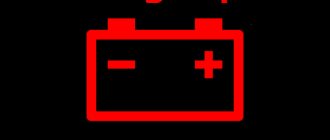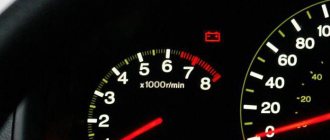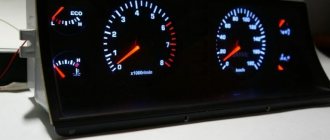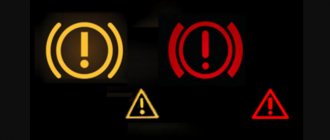Welcome, friends, to the DIY auto repair website. When you turn the ignition key, a number of warning lights come on on the dashboard. They signal that the system is working properly and the engine is ready to start.
The battery charging light is on
One of these indicators has an image of a battery. When you turn on the ignition, it starts to light up, and after starting the engine, it goes out.
This indicates that the battery is charging. But what if this does not happen? Why does the battery charging light stay on even after starting?
A little theory: scheme of work
To solve the existing problem, you must understand the essence of the interaction between the vehicle generator and the power source (battery).
While driving, the battery is in constant charging mode with a voltage of 13.6-14.2 Volts. As engine speed increases, the voltage at the generator output increases. But this is unacceptable.
To limit the voltage, a small relay regulator is inserted into the rotor excitation circuit. Its task is to reduce the current to a normal level (even with a significant increase in the speed).
The result is maintaining the battery charge voltage at a stable level. If the battery light is on, this indicates a lack of charging from the generator.
How does the scheme work? After turning on the ignition, voltage through fuse No. 10 (for VAZ-2107) is supplied to the battery charge indicator lamp.
Next, the “+12V” voltage passes through a diode, a built-in relay-regulator (we mentioned it above), a brush, a slip ring and a winding.
As soon as the rotor speed increases, the phase voltage also increases. As a result, the voltage at the terminals of the battery warning light is equalized and it goes out. At the same time, the battery is charging.
Ways to troubleshoot battery problems
First of all, you need to check the battery charging while the engine is running. During normal charging, the voltage will be in the range of 13.6 - 14.2 Volts. If the charge is weak, the value will be below 12 Volts (the author of the video is VAZ 2101-2107 repair and maintenance).
To troubleshoot problems, you need to prepare instructions with a diagram of the electrical equipment of the VAZ 2110 car and the necessary tools:
- pliers;
- flat and Phillips screwdrivers;
- multimeter;
- 12 V indicator light;
- knife;
- sandpaper.
Checking the battery on a car
There are the following troubleshooting methods, which can be determined by how the battery light lights up and goes out:
- If the charge indicator on the dashboard does not light up, this indicates that the battery is low. The reason why the battery is not charging may be due to oxidized contacts. The contacts on the battery should be cleaned. If this does not help, you need to measure the voltage at terminal “30” of the generator. To do this, one probe must be connected to ground, and the second to terminal “30”. If the flowing current greatly exceeds the charge on the battery, it is necessary to clean the terminal on the generator. It is possible that the wire connecting the generator to the device needs to be replaced.
- If the voltmeter on the dashboard and the warning light show that there is a charge, but the battery is discharged. In this case, the charge at the terminals is within normal limits, and when the equipment is turned on, the charge arrow occupies the extreme left position. This indicates insufficient tension on the generator drive belt or damage to it.
- The battery may not charge due to a breakdown in one of the diodes, as well as a break in the starter winding. In this case, with the ignition off, use a multimeter to check the diodes and, if necessary, replace them.
- The battery is not charging, but the indicator does not light up and the charge sensor does not work. The reason is a blown fuse F10.
- If the ignition is on, all devices are working, the charging indicator does not light up, and there is no charge, then you need to check the generator. To do this, remove the wire from terminal “61” on the generator and connect it to the car body, which will act as a “minus”. A lit battery indicator indicates a problem in the excitation winding of the generator device. The reason may be poor contact at the connection point. In this case, you need to clean the contacts. If this does not fix the problem, it is possible that the cause is a burnt-out lamp.
- When you turn the key in the ignition, the battery charging light comes on, but when the engine starts, it does not go out. In this case, there is no charging or it may periodically disappear, this indicates that the battery is discharging. The reason is insufficient contact in the place where the instrument panel is connected. It is possible that they have oxidized and need to be cleaned.
- The relay regulator should also be checked. To do this, you need to apply voltage to the contacts from the battery. If it is 12 volts at the brushes, then the relay is working properly. Otherwise it should be replaced.
- If the electrolyte level is insufficient, add the required amount of distilled water.
- If the battery case is damaged or the service life has expired, it should be replaced.
Sorry, there are no surveys available at this time.
Reasons why the battery charging light is on
In fact, there are many reasons why the battery light comes on and does not go out. These include:
- Loosening of the belt tension on the generator, its wear or damage;
- fuse blown or deterioration of contact quality in the connectors of the mounting block;
- breakdown of the relay regulator, diode bridge, additional diodes;
- the appearance of a break in the generator excitation circuit;
- decreased quality of contact at the battery terminals or generator output;
- generator brush wear;
- lack of high-quality contact of the ground wire.
What to do if the battery charging light is on?
First of all, get out of the car and, with the engine running, measure the voltage at the battery terminals (do not remove the clamps under any circumstances).
If charging is in progress, the voltage should be at 13.6-14.2 Volts. In the absence of charge, the voltage level will be much lower - about 12 Volts.
To fix the problem, prepare the following tools:
- twelve volt indicator light,
- two screwdrivers (flat and Phillips),
- multimeter,
- pliers,
- knife,
- Use sandpaper to clean contacts.
So let's get started:
1. The readings of the on-board voltmeter indicate the presence of a charge, the charge signal lamp on the dashboard does not light up, there are about 12 Volts at the battery terminals, and the battery itself is almost discharged.
In such a situation, clean the wire connections on the power source itself. If these measures are useless, measure the voltage level at terminal “30” of the generator itself.
Place one multimeter probe on this terminal, and the other on ground. If the voltage here is much higher than at the battery, then strip the thirtieth terminal. If necessary, replace the wire from the generator to the battery.
2. The voltmeter on the dashboard and the lamp show the presence of a charge, but the battery is discharged.
The voltage on the battery is normal (about 14 Volts). Turning on a load (for example, headlights) causes the charge arrow to shift to the extreme left position.
The main reason is weak belt tension on the generator pulley (tension the belt, and if it is damaged, replace it).
This problem can also be caused by a breakdown of one of the diodes, as well as a break in the stator phase winding. Turn off the ignition and check the diodes with a multimeter. In case of breakdown, replace them.
Check the generator brushes. To do this, take them out and measure the length. If it is less than five millimeters, then it is better to replace the brushes.
3. When you turn the key in the ignition, the charge warning lamp does not light up, the charge sensor does not work, and there is no charge on the battery. The reason is a blown fuse.
Its designation is F10, rating is 10 Amperes. If installing a new fuse does not produce results, then the reason must be sought in the ignition relay or the lock itself.
4. After turning on the ignition, there is no charge, all devices work, the control warning lamp does not light up.
The check is simple - remove the wiring from terminal “sixty-one” of the generator and connect it directly to the “minus” (car body). If the light comes on, then the cause of the problem is the generator field winding.
The second option is bad contact in the connector. If after cleaning there is no result, then there is a risk of the lamp itself burning out.
5. When you turn the key in the ignition switch, the charge lamp lights up, and after starting it continues to light up. In this case, there is no charging or appears periodically. The reason is insufficient contact of the wire at the connector with the dashboard (it may oxidize).
Finally, check the relay regulator. To do this, apply voltage from the battery to its contacts. If there is 12 volts on the brushes, then the relay is working properly. If not, the device must be replaced.
Diagnostics
Due to the fact that the price of a new generator is “biting”, and maintainability is quite high, many motorists do it themselves with their own hands to eliminate generator malfunctions in the VAZ 2110, which I suggest you do with the help of these instructions:
Fault No. 1
In the case when the control light on the instrument panel indicates a discharge of the battery, and when checking with a tester in the electrical circuit of the car, the voltage does not rise above 13.2 volts, it is necessary to check:
Checking the voltage in the on-board network
- Tension of the VAZ generator drive belt - tighten if necessary;
- If the rectifier block valve is damaged, replace the entire rectifier block;
- Diodes powering the exciting winding of the rotor - replacement of diodes or the entire rectifier block;
- The outputs of the exciting winding coming from the slip rings for their unsoldering - solder the outputs/replace the rotor or the entire generator assembly.
It is also possible that the stator winding may short-circuit, break or short circuit to ground (in this case, noise from the generator appears in the VAZ 2110, the generator “howls”). These assumptions are checked using an ohmmeter; if a malfunction is detected, the stator or the entire generator must be replaced.
Malfunction No. 2
The warning lamp in the instrument panel also indicates that the battery is low, and the tester displays a voltage value in the vehicle circuit of at least 14.7 volts:
The voltage regulator has definitely failed (the contacts of the “DF” output have closed with ground) - replace the regulator.
Malfunction No. 3
The generator noise is clearly audible in the VAZ 2110:
- If sounds such as howling and squealing are heard. When disconnected, the wires remain, and when the drive belt is removed, they disappear, this means that the bearings have failed - replace the bearings (the front one is replaced as an assembly with a cover);
- If, when the wires are disconnected, the noise disappears, this indicates a short circuit in the stator windings and their connection to ground—replace the stator/generator.
Also in this case, one of the valves may close, which threatens to replace the rectifier unit.
https://youtube.com/watch?v=oK5FpoIF6i8
Malfunction No. 4
The warning lights in the instrument panel do not light up when turning the ignition key:
- Checking the “F19” fuse in the mounting block - replacement (it is advisable to find out the reason for the fuse failure);
- Open circuit in the “ignition switch” instrument cluster - check the integrity of the blue wire with a red stripe running from the mounting block to the ignition switch. as well as an orange wire running from the instrument panel to the mounting block;
- Malfunction of the ignition switch contact group - check the presence of a contact with a tester, if necessary, replace the contact group or the entire ignition switch.
Malfunction No. 5
When the ignition is turned on and the engine is running, the warning lamp indicating a low battery does not light up, the remaining lamps in the instrument cluster work:
- Burnt-out control lamp/poor contact – replace the burnt-out lamp/clean and press the contacts in the seat;
- Open circuit “generator output “D” to the instrument panel” - check for continuity of the brown wire with a white stripe coming from terminal “D” to the instrument panel;
- Oxidation of contact rings, as well as hanging and wear of brushes - the brush holder assembly with brushes should be replaced, the contact rings should be wiped with a clean cloth moistened with a degreaser;
- Open circuit “DF terminal – ground” (damage to voltage regulator) – replace the regulator;
- Broken brush holder wire from terminal “D+” - restore contact;
- The positive diodes (valves) have closed - replace the rectifier unit;
- The leads coming from the slip rings to the rotor excitation winding have been unsoldered - solder the leads in place/replace the rotor/replace the generator.
This is where the list of the main malfunctions of the VAZ 2110 generator ends, I hope that this instruction will help you out at the right moment. As they say - no nail, no wand)))
VAZ 2110 battery light is on
Photo of the instrument panel of a VAZ 2110 car. The battery lamp is third from the left in the bottom row.
It is possible, for example, a loss of current when the car is turned off, or increased consumption of on-board electronics during a trip. And even under normal discharge conditions, the generator may fail and will not replenish the battery charge due to a malfunction. If when starting the VAZ 2110 the battery lamp on the dashboard lights up . then the latter option takes place.
But why exactly the generator does not supply voltage is quite difficult to immediately determine. The most obvious scenario is that the belt is loose and the generator simply does not reach the required speed for operation. Then you just need to tighten the belt and monitor the behavior of the light bulb. If even after this the battery does not charge, the voltage regulator may be the culprit.
Where to look for the reason?
- You should not immediately dismantle the generator, it is in vain. Carry out diagnostics in the brush compartment on the generator. If there are visual defects or sticking, replace with new ones and test the car. If the cause cannot be eliminated, proceed to the next step;
- Diode bridge:
it is not subject to partial replacement or maintenance, only complete replacement. At the same time, check to see if there is a burnout at the place where it is attached, as there may be a short to the winding in the rotor. See the article “How to check a diode bridge”; - Relay problems:
Perhaps no current is supplied to it due to oxidation of the contacts. It is necessary to carefully disconnect the contacts and clean them with fine sandpaper or a triangular file. Using a voltmeter, check the output voltage at the generator, first resetting the positive terminal. The standard voltage should be 14.2–14.3 V. If the voltage is less than normal, then it is necessary to disassemble the generator and look for a breakdown in the rotor and stator windings; - Another common cause of a short circuit is water getting into the generator, for example, during a drive into a puddle. After this, the car is powered only by the battery;
- A poor-quality timing belt can also cause inconsistent battery charging due to slipping. This can be corrected by tensioning it using a pry bar and a spanner. Otherwise, replace the belt. Article on the topic “Which timing belts are better?”;
- Fuses
responsible for the operation of the dashboard. To do this, you need to look at the fuse number in the operating instructions and change it to the appropriate one. If it's not in stock, be sure to purchase it.
Here, in fact, this is the end of the topic of why the VAZ 2110 battery light is on. All common causes are discussed, as well as ways to eliminate them. We hope that our recommendation article will help many drivers quickly find and fix problems, thereby extending the life of the vehicle. Let problems bother your car as little as possible. Good luck to you.
Source
The battery light is on - what does it mean?
There can be only one reason why the battery warning light comes on while the engine is running - there is no voltage supply from the generator or its value is insufficient.
The main malfunctions that lead to this:
- Lack of quality contact at the battery terminals.
- Damage to the alternator belt or loose tension.
- There is no negative contact with ground.
- An open circuit in the rotor excitation circuit or worn brushes in the generator.
- Failures of the diode bridge are usually accompanied by a dim lighting of the battery light on the dashboard.
- Fuse failure.
- Malfunction of the relay regulator.
Before you start troubleshooting, pay attention to why the lamp is on. If there is no voltage supplied to the battery at all, then the lamp lights up correctly. In another situation, the operation of the signal indicator while charging is present significantly complicates the problem.
First of all, determine whether there is voltage on the battery. To do this, take a voltmeter (multimeter), start the engine and measure the required characteristic at the battery terminals.
If everything is in good condition, you will see readings in the range from 13.6 to 14.2 V. In this case, the battery is charging properly. If the results obtained differ significantly from normal, then there is some kind of breakdown in the system.
A few words about how the battery-generator tandem works
Everyone, even a novice driver, knows that the battery interacts with the generator. After starting the engine, the battery goes into constant charging mode. After the engine speed increases, the voltage at the generator output also increases, which is not a “hum”.
In order to prevent the above described, a small relay-regulator is installed in the rotor excitation circuit, the task of which is to reduce the current to the optimal level, regardless of the engine speed. As a result, the voltage is maintained at the required level. The battery light comes on when there is no charging from the generator.
So, let's simulate the situation. You started the engine, but the battery light did not go out. What's the matter?
- Faulty relay-regulator, diode bridge;
- Poor tension of the generator belt, critical wear or belt slippage. Wear (play) of the generator bearing;
- Blown fuse or poor contact;
- Poor contact at the battery terminals, at the generator terminal or at the ground wire;
- Open circuit of the generator excitation circuit, serious wear of the generator brushes or brush holders;
- Wearing out the ignition switch is an option, but in this case several lights will light up at once.
Poor contact at battery terminals
Check the condition of the battery terminals and battery contact wires.
It is not uncommon for oxidation to occur in these places and the contact to weaken significantly. When the lamp comes on and there is charging, this could be the cause. In this case, the generator operates normally, voltage is supplied to the battery, but weakens due to insufficient contact. As a result, the warning light on the dashboard comes on. As a rule, the indication lights up dimly.
To fix the problem, you need to clean the terminals and contact pins. Additionally, treat these elements with a water-repellent agent.
Video “Which battery to choose”
This video provides recommendations for choosing a battery (the author of the video is GrigoryFF)
On domestically produced cars, the dashboard is not informative enough. However, it contains all the main indicators of the operation of the main components and systems of the vehicle. Sometimes a situation occurs when something goes wrong, but it is impossible to determine the malfunction at the initial stage.
From this article you will learn why the battery charging lamp is constantly on or a weak indication appears. Why this happens and what to do, read on.
Diode bridge faults
The electrical circuit is designed to convert alternating voltage to direct voltage. If a breakdown of at least one of the diodes occurs, the functional unit ceases to perform its duties. The consequence of this is the supply of voltage that does not correspond to the required indicators.
The rectifier needs to be checked when the battery charging light is on, but there is charging.
You can determine the breakdown by using a multimeter. Take a tester and connect the red probe to the positive of the bridge, and the black one to one of the contacts marked AC.
The throughput voltage for diodes (silicon) ranges from 400 to 1000 mV. If the tester shows different values, then the bridge needs to be changed. Such a unit cannot be repaired.
Messages 5
1 Topic by kvs_9090 2013-06-15 15:33:56
- kvs_9090
- New member
- Inactive
- Registration: 2013-06-15
- Messages: 1 Thanks : 0
- Car: VAZ2111
Topic: Resolved: Battery charging lamp is on full-on
The charging lamp lights up at full intensity, but at rpms above 2000 it goes out, but at idle it lights up again. what is the problem??
2 Reply from Admin 2013-06-15 19:02:03
- Admin
- Administrator
- Inactive
- Registration: 2012-02-20
- Messages: 3,257 Thanks : 624
Re: Resolved: Battery charging lamp is on full-on
3 Reply from vlad 2013-06-18 23:39:13
- vlad
- New member
- Inactive
- Registration: 2013-06-18
- Messages: 6 Thanks : 1
- Car: VAZ 21124
Re: Resolved: Battery charging lamp is on full-on
The battery has stopped charging and the battery charging indicator lamp does not light up. Tell me where to look!?
4 Reply from Admin 2013-06-19 04:47:38
- Admin
- Administrator
- Inactive
- Registration: 2012-02-20
- Messages: 3,257 Thanks : 624
Re: Resolved: Battery charging lamp is on full-on
vlad , when the tidy is turned on, does the discharge lamp light up? Most likely the problem is in the generator, or in poor contact or wiring.
5 Reply from vlad 2013-06-19 23:51:34
- vlad
- New member
- Inactive
- Registration: 2013-06-18
- Messages: 6 Thanks : 1
- Car: VAZ 21124
Re: Resolved: Battery charging lamp is on full-on
When the device was turned on, the charge lamp did not light up. The reason was in the gene. Thank you!
Source
Fuse failure
The electrical circuit for charging the battery is protected by a fuse. This element is located in the vehicle’s mounting block and is marked as F10. However, before checking for a malfunction in this place, it is better to first read the vehicle’s operating instructions, in which you will find out the exact designation of the required element.
If the fuse fails, the battery is not charged at all. However, there are times when the warning light comes on, but there is charging.
You can check the element using a tester (the part is removed from the mounting block). If the multimeter shows that the fuse is bad, all you have to do is replace it.
Description of battery operation
A battery is a device with the help of which electrical energy is obtained from chemical energy and vice versa, with the ability to accumulate and store charge. The main purpose is to provide power to the electrical equipment of an idle vehicle, as well as to start the engine using the starter. If the generator does not work or cannot cope with the load, the battery takes over its role. The generator does not allow the battery to discharge, as it is a source of recharging.
Based on the type of electrolyte, rechargeable batteries are divided into two large groups: alkaline and acidic; based on the material of the electrodes, they are divided into:
- lead;
- zinc with the addition of silver;
- nickel-cadmium;
- iron-nickel.
Lead-acid batteries are the most popular. The principle of operation of the battery is simple: thanks to chemical processes, an electric current is generated, which is necessary to start the engine. A running motor receives electricity from a generator. In this case, electrical energy is obtained from mechanical energy. The battery receives electricity from the generator and converts it into chemical energy, storing it for further use.
Failure of the relay regulator
A malfunction of the relay regulator is another reason why the battery charging light comes on.
This node is responsible for turning on/off the signal indicator. The principle of operation of the device is as follows: when the ignition is turned on, current flows through its closed contacts, which comes from the battery and feeds the indicator signals. When the internal combustion engine starts, the generator starts working, which supplies the relay with already rectified voltage and the contacts of the unit open. At this time the light should go out.
You can check the part yourself. Disconnect both wires from it and short them together. Start the engine and look at the dashboard. If there is no indication, you need to change the relay.
What needs to be done?
First of all, as soon as the driver sees the signals from the oil pressure lamp, it is necessary to stop (if the indicator operates while the car is moving).
To troubleshoot problems, in some cases you may need the help of service station specialists. However, some actions are quite accessible to every driver:
- Check the engine oil level - if it is below the Min mark, add fluid. You should not add oil to the Max mark; a level between Min and Max will be quite sufficient.
- If after this the oil pressure light does not go out, you should think about the quality of the oil and filter used. It is quite possible that you have not replaced either one or the other for a long time.
Along with the oil, the filter also needs to be changed. - Also, one of the most likely reasons for the appearance of the oil can icon on the panel is the presence of dirt and deposits on the engine sump. You will need to clean the pan - it is quite possible that the indicator will disappear.
In cases where the reason for the oil pressure lamp to light up is due to more serious reasons - for example, a short circuit or defects in the oil pump, the help of a specialist will be required.
Useful tips
To prevent your car from having problems charging the battery, use the following tips:
- Don't ignore your car's dashboard signals. In this case, you will be able to solve the problem at the initial stage of its development.
- Inspect the alternator belt regularly. The correct operation of all electrical equipment on board directly depends on it. If there are any defects, replace it as soon as possible.
- Check the voltage from the generator to the battery. If you notice a discrepancy, diagnose the on-board network.
- Periodically pay attention to the condition of the battery terminals. If you notice oxidation, eliminate this defect. They can be treated with WD-40.
- Isolate the generator and battery from water to prevent short circuits. Leave engine washing to professionals.
- When repairing the battery charging circuit, do not use cheap spare parts.
To summarize, we note that the battery is the most important element in the car’s electrical network. Therefore, you should carry out timely maintenance of the charging circuit and, if necessary, change the necessary parts. In this case, you will ensure a proper system of work. In the article, we told you about the main malfunctions that can cause the battery charging lamp to light up and what to do about it. We hope our recommendations will help you in solving the problem at hand.
To post a reply you must log in or register.
Common reasons why the battery light is constantly on
These include the following cases:
- The alternator drive belt is loose, worn or torn;
- the fuse has blown in the section of the circuit from the ignition switch to the control light (in this case there is charging);
- contact is broken in the connector blocks of the mounting block;
- malfunction of the relay regulator;
- diode bridge malfunction;
- malfunction in the circuit of additional diodes;
- break in the current supply circuit to the rotor electromagnets;
- poor contact at the battery terminals;
- lack of supply current at the output of the generator;
- the generator brushes are worn out;
- there is no ground on the negative wire.
The source of many faults in the battery charging system is the generator voltage regulator relay
The light may sometimes come on when the turn signal is turned on.
The most common reason is a malfunction of the diode bridge, poor contact in the rotation fuses, or poor contact in the ground wire of the instrument panel. It is necessary to check the contacts of all terminals on the wires coming from the generator. The problem must be fixed. Indeed, if the generator malfunctions (a break in one of the three diodes), the battery will no longer receive a full charge and after some time will be completely discharged every time the turn signals are turned on and/or off.
The light bulb goes out and burns at full intensity
A battery light that barely burns at half intensity while the engine is running indicates a generator malfunction: the diode bridge or insulation in one of the stator windings is broken. Less commonly, there is a problem with the ignition switch. The key cannot turn all the way due to accumulated dirt. A few drops of WD-40 “liquid key” into the ignition key hole will alleviate the situation. Sometimes it may be necessary to repair the car's electrical wiring and timely diagnose a decrease in the signal to the indicators.
The light comes on when the speed increases
This is a signal that charging has stopped when you press the gas pedal. The most common cause of this malfunction is wear of the slip rings on the generator shaft. There are problems with the belt, brushes or bearings of the generator. The malfunction must be found and eliminated. Otherwise, due to loss of charging, the battery may fail at the most inopportune moment.
The light comes on at idle
The light comes on as soon as the car starts. Sometimes the reason is simple. When the engine is idling, powerful current consumers are turned on: air conditioning, headlights, windshield wipers. The load on the generator increases sharply and the battery simply does not have enough charge. The light starts flashing periodically. If the alternator belt is loosely tensioned, then when you turn on the headlights or air conditioning, you can hear the squeal of a slipping belt. But a battery light burning at low speeds can also indicate a malfunction of the relay regulator or rectifier bridge. In any case, the fault must be found and eliminated.
The light flashes periodically when the engine is cold
A flashing battery light requires you to pay special attention to the generator. Perhaps the brushes or copper slip rings on the armature shaft are worn out. Perhaps there is a bad contact in one of the phases of the diode bridge
Often the cause of this malfunction is loosening of the nuts securing the contacts of the diode bridge or oxidation of the closing surfaces of the contacts
Perhaps there is a bad contact in one of the phases of the diode bridge. Often the cause of this malfunction is loosening of the nuts securing the diode bridge contacts or oxidation of the closing surfaces of the contacts.
The battery charge control lamp lights up when the headlights are turned on.
The light comes on when the headlights are turned on
This is the reason why the generator cannot produce rated voltage when the load increases. It is necessary to check the AC source for a break in one of the phases of the diode bridge, wear of the commutator rings or brushes.
The light remains on when the ignition is off
In this case, the current to the light bulb can only come from the ignition system. It is most likely that there is a problem with the ignition switch, the switched on contact of the ignition unloading relay or the car alarm.
Damage to the mass air flow sensor
The faulty engine warning light may also come on if there are problems with the air flow meter. Such a sensor (mass air flow sensor) often fails or starts to work incorrectly, which leads to problems with the motor. Problems with the mass air flow sensor in the VAZ 2110 engine can be indirectly determined by significantly increasing fuel consumption. Note that it is not recommended to operate an engine with such breakdowns, so if the Check Engine light comes on and fuel consumption increases, it is best to go to a service center and carry out high-quality computer diagnostics. The cost of spare parts and repair work in this case is not too high, which will allow you to fully restore the functionality of your car.
Lambda probe failure
On 16-valve modifications of the VAZ 2110 engine, a lambda probe is installed, which is responsible for analyzing exhaust gases. Over time, a layer of used oil appears on the surface of such a lambda probe, which leads to problems with the accuracy of the sensor’s readings. As a result, the Check Engine light comes on, and the car must be taken to a service center. It is impossible to independently determine the problem with the lambda probe. Only when diagnosing a car using special equipment can you determine the corresponding error codes, on the basis of which problems with the lambda probe will be identified. This element cannot be repaired and if it breaks, it is simply replaced with a new one.











